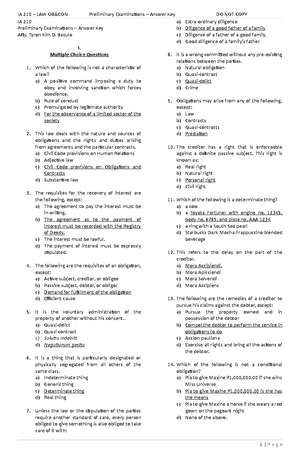- Information
- AI Chat
Was this document helpful?
T02 - Installment Sales & Consignment Sales
Course: Accountancy (AC1218)
999+ Documents
Students shared 2091 documents in this course
University: Far Eastern University
Was this document helpful?

INSTALLMENT SALES
Installment Method
Criteria
11. The installment method of recognizing revenue
a. should be used only in cases in which no reasonable basis exists for estimating the
collectibility of receivables.
b. is not a generally accepted accounting principle under any circumstances.
c. should be used for book purposes only if it is used for tax purposes. S, S & S
d. is an acceptable alternative accounting principle for a firm that makes installment sales.
46. Slick's Used Cars sells pre-owned cars on the installment basis and carries its own notes
because its customers typically cannot qualify for a bank loan. Default rates tend to be high or
unpredictable. However, in the event of nonpayment, Slick's can usually repossess the cars
without loss. The revenue method Slick would use is the:
A. Installment sales method. C. Cost recovery method.
B. Point of sales method. D. Completed contract method. S, S & T
21. The installment method of recognizing profit for accounting purposes is acceptable if
a. collections in the year of sale do not exceed 30% of the total sales price.
b. an unrealized profit account is credited.
c. collection of the sales price is not reasonably assured.
d. the method is consistently used for all sales of similar merchandise. K, W & W
1. Cash collection is a critical event for income recognition in the
AICPA 1193 T
-
39
a.
b
.
c.
d.
Cost
-
recovery method
No
Yes
No
Yes
Installment method
No
Yes
Yes
No
2. An acceptable method for recognizing profit when the collection of cash is in doubt is the
a. Percentage-of-completion method. c. Completed-contract method.
b. Installment method. d. Consignment method. CMA 0685 4-35
3. For financial statement purposes, the installment method of accounting may be used if the
a. Collection period extends over more than 12 months.
b. Installments are due in different years.
c. Ultimate amount collectible is indeterminate.
d. Percentage-of-completion method is inappropriate. AICPA 1191 T-6
4. To properly account for an installment sale, all of the following must be readily determinable
except
A. The amount of gross profit to be deferred.
B. The total cash collected on each year's sales.
C. The operating costs to be deferred.
D. Costs associated with default and repossession. CMA 1292 2-20
5. If sales are accounted for using the installment method, which of the following is (are) only
recognized in proportion to the cash collected on the sales during the period?
A. Sales.
B. Sales and cost of sales.
C. Sales and cost of sales and selling expenses.
D. Sales and cost of sales and administrative expenses. CIA 0595 IV-11
Characteristics
13. When using the installment sales method,
a. gross profit is deferred until all cash is received, but revenues and costs are recognized in
proportion to the cash collected from the sale.
b. gross profit is recognized only after the amount of cash collected exceeds the cost of the
item sold.
c. revenue, costs, and gross profit are recognized proportionally as the cash is received from
the sale of product.
d. total revenues and costs are recognized at the point of sale, but gross profit is deferred in
proportion to the cash that is uncollected from the sale. S, S & S
Installment Receivable Balance
6. Pie Co. uses the installment sales method to recognize revenue. Customers pay the
installment notes in 24 equal monthly amounts, which include 12% interest. What is an
installment note’s receivable balance six months after the sale?
a. 75% of the original sales price.
b. Less than 75% of the original sales price. AICPA 1192T-9
c. The present value of the remaining monthly payments discounted at 12%.
d. Less than the present value of the remaining monthly payments discounted at 12%.
Deferred Revenue
65. Alton, Inc. is a retailer of home appliances and offers a service contract on each appliance
sold. Alton sells appliances on installment contracts, but all service contracts must be paid in
full at the time of sale. Collections received for service contracts should be recorded as an
increase in a











